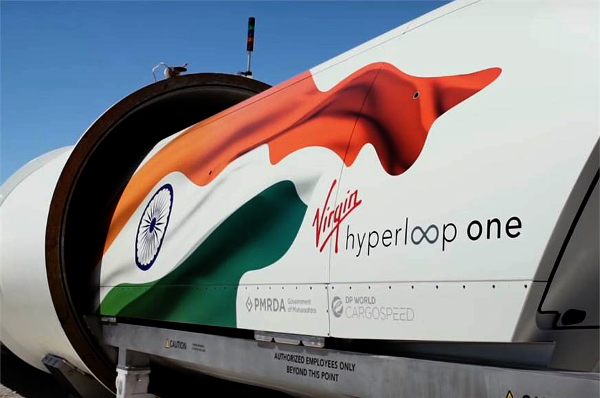India lags the world in many exponential technologies. The United States and China have taken a lead in work around Artificial Intelligence, for instance. Nevertheless, there is one technology where India could possibly be its earliest adopter – Hyperloop.
India is a bit ahead of both the United States and Europe in terms of regulation. The Office of the Principal Scientific Adviser to the Government of India has been designated as the relevant authority to develop Hyperloop standards. Late last year, a ‘Consultative Group at the Office of Principal Scientific Adviser on Future Transportation’ was constituted. And now, the Government of Maharashtra is expected to kick off the public procurement process for a Hyperloop project between Mumbai and Pune, soon. Over the next few months, when Maharashtra floats a tender, it could be the world’s first.
For nearly a century, there hasn’t been a new mode of transportation. Came Hyperloop, which now promises to take people in a pod direct to a destination at speeds above 1,000 kilometres an hour – the pods will travel via electric propulsion in a low-pressure tube. This sort of speed is nine-10 times faster than traditional rail. Vande Bharat Express, designed and built by India’s Integral Coach Factory, reached speeds of 180 kilometres an hour during trial runs.
Virgin Hyperloop One, a company interested in building and operating the Mumbai-Pune route, writes on its website: “The vehicle floats above the track using magnetic levitation and glides at airline speeds for long distances due to ultra-low aerodynamic drag. Virgin Hyperloop One systems will be built on columns or tunnelled below ground to avoid dangerous grade crossings and wildlife. It’s fully autonomous and enclosed, eliminating pilot error and weather hazards.”
The Mumbai-Pune travel time, which currently takes over two hours by road, will effectively shrink to 25 minutes.
Business Today recently spoke to Harj Dhaliwal, Managing Director of Middle East and India, Virgin Hyperloop One, to understand company’s plans in India. The company was founded in June 2014 and has thus far raised $295 million from DP World, Caspian VC Partners, Virgin Group, Sherpa Capital, Abu Dhabi Capital Group, SNCF, GE Ventures, Formation 8, 137 Ventures, WTI, among others.
While the company started engagements with many Indian states over the last two years, a strong business case emerged in Maharashtra.
“These projects cannot go forward without a champion, without somebody at the head of the government who leads the transformation,” Dhaliwal says. “Devendra Fadnavis, the Chief Minister, saw the vision – how India can position herself,” he adds.
Virgin Hyperloop One, part of an international consortium that also includes supply-chain company DP World, has proposed largely a privately financed project. The state government, though, will need to arrange the land for constructing the 117.5 kilometer corridor.
“When we started engaging with the government, it became clear that we will not get the land the way we want it. The state was very clear they would work with us in partnership to acquire the land that we need. Lot of the land is already in the state’s ownership. We decided to adopt the route along the corridor of the Mumbai-Pune Expressway,” Dhaliwal says.
The proposed alignment of the route, along the Mumbai-Pune Expressway, while reducing private land acquisition will increase the time taken for pods to reach its destination.
Initially, the company estimated a travel time of 14 minutes – that was if it got the land as needed to optimise speed. The speed was subsequently halved from over 1000 kilometers an hour and the journey time increased to 25 minutes. This, Dhaliwal says, wouldn’t impact demand. There is a potential to connect 26 million people between two cities and support 150 million passenger trips annually. Pods, which resemble a bullet train coach, can be dispatched several times per minute – upto 16,000 passengers per hour per direction at peak capacity.
How much would a ticket cost? Dhaliwal wouldn’t let it out since the public procurement process is around the corner. Nevertheless, he clarifies that fares will be competitive versus other modes of transport. “A mass transport system has to be available and accessible to all. It is not a transport system for the few. We also understand that there are other modes of transport in the corridor – trains, flights, the Expressway. We have to be competitive,” he says.
Investments required for the project are staggering. The entire stretch of 117.5 kilometers has been proposed in two phases and commercialisation could take nearly a decade. The first phase is a stretch of 11.5 kilometers and will need half a billion dollars.
“We will raise the investment, build it, test it, and then work with the Government of India and Maharashtra to get it certified. Once certified, the consortium will raise the money for phase two. I think this is a very safe and pragmatic plan,” the executive says.
The hyperloop system is expected to create a global manufacturing and supply-chain hub in India, and could potentially employ 1.8 million in Maharashtra.
“We did an analysis with KPMG. About 74 per cent of the component we require to build the Hyperloop system can be sourced in India. Of the 74 per cent, about 70 per cent of the component manufacturing can be done within Maharashtra,” Dhaliwal says.
Importantly, early adoption of the technology would put India right at the forefront of the next revolution in transportation, for the next 100 years.
Source: BT
Image Courtesy:Autocarindia
You may also like
-
Trade Connect E-platform For Exports Is Single Window, Fast, Accessible And Transformational: Shri Piyush Goyal
-
Dot Simplifies Approval Processes For Telecom Licenses And Wireless Equipment
-
Coal Production and Supply Trends on Positive Trajectory
-
Union Minister To Release Booklets On Promotion Of Indigenous Species & Conservation Of States Fishes
-
2nd India-Japan Finance Dialogue held in Tokyo on 6th September, 2024
